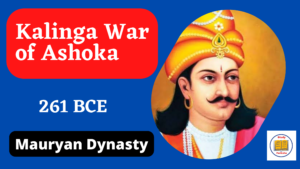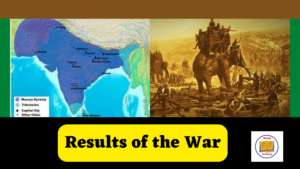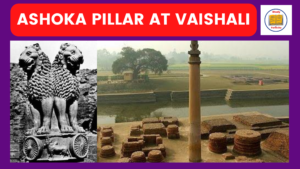Detailed History of Kalinga War of Ashoka. Important UPSC Notes for Preparation, Empire Ashoka Policies reforms and Smarat Ashoka Empire Map

Kalinga War of Ashoka Empire
After the death of his father Ashoka ascended the throne of Patliputra. On account of his great achievements he is considered to be one of the most glorious emperors not only of India but of the whole world.
Ashoka was a Very Ambitious Emperor and followed the Forward Policy of his father and Grandfather by Conquering New Countries to Extend his Empire. He also Followed the Policy of maintaining friendly relations with foreign powers. He sent his ambassadors to other countries and receive the ambassadors of the foreign countries. He also appointed some foreign nationals in the service of the magadha Empire. He also prepared a plan to conquer those parts which were still outside the pale of the Magadha Empire.
Ashoka inherited a vast Empire from his father which extended from the Hindu Kush mountains to the bay of Bengal and from Nepal and Kashmir in the north to Mysore in the south. But he was not satisfied with it and wanted to extend them further by making further conquests.
so now he made plans to attack and conquer the vast lands lying in between the Mahanadi and Godavari. This area in those days form the state of Kalinga.
Kalinga War With Ashoka ( Empire of Ashoka )
Describing the strength of the Kalinga armies magesthenese writes that the army was composed of 60000 foot soldiers infantry 10,000 horse soldiers cavalry and 700 elephants. To defend the Honour and freedom of their country the army of Kalinga fought very bravely and also the inhabitants made great sacrifice in saving their freedom.

it was on this account that the war proved to be the bloodiest in which thousands of soldiers were killed and many more rounded and became maimed for life. In the end Ashoka came out victorious about 150 thousand Kalingas were captured as prisoners of War, 1 lakh soldiers were killed and many lakhs of people died of the diseases that spread out as a result of War. After the victory of the Kalinga Ashoka appointed one of his sons as governor of Kalinga and came back to his capital Patliputra.
Results and Effects of Kalinga War Information
The Fierceness of the war produced great effect on the heart of Ashoka. The loss of thousands of lives in the battle of Kalinga melted his heart and he was filled with a sense of remorse. He renounced the policy of War for good and gave up the idea of extending his Empire further. In place of War he adopted the policy of establishing friendly relations.
he announced that in future he would not repeat the experiment of Kalinga. He released all the prisoners of War and provided relief to the families of the founded and the killed people. Buddhism became the Religion of Ashoka He Renounced the Policy of Bherighose and in its place adapted the Policy of Dharamghose. He became a Buddhist and began to devote all his time for propagating the Buddhist religion.
he sent his son Mahendra his daughter sanghamitra and many others on various mission for the spread of Buddhism in many countries.
Ashoka Policy of the War
Ashoka’s Policy of the Renunciation of war proved to be Harmful to the Magadh Empire. The Empire began to decline and it began to be feared that it would be shattered because people though that the emperor would not resort to force or bloodshed. But in other fields the policy proved to be useful and profitable.

religion and culture developed by leaps and bounds, Ashoka carried the message of Indian culture and religion to far off regions of this world. New age began in India after the Kalinga war with Ashoka. The old age of wars, bloodshed conquest and extension of dominions ended and a new age of peace, love tolerance and social progress began.
the importance of the military force begin to decline and that ultimately led to the decline of the Empire
The Extent of the Empire of Ashoka Emperor
We get the knowledge of his Empire from his Rock and pillar inscriptions, his dominions in the West extended from Afghanistan Balochistan to the bay of Bengal and Kalinga in the East. Nepal was also included in his dominions. The extent of his Empire was larger than the empires of his father and grandfather for the convenience of administration he divided his Empire into four zones.
and interested the governance of these zones to his son’s the governor of Takshila ruled over Northern provinces the governor of Ujjain ruled over the Western provinces the governor of toshali ruled over the southern provinces and the governor of Patliputra ruled over the eastern provinces
Ashoka Foreign Policy and Relations
During His Reign there were four states in the far south and Ashok maintain friendly relation with all of them. He had sent religious missionary to propagate Buddhism in all these four states. Ashoka maintain friendly relation with foreign kingdoms also in his foreign relations he followed the policy of his father and grandfather. He sent religious missionaries to many foreign countries he sent religious features to single do it and Burma also and from this we may conclude that here relation with this country also.
Religion of Ashoka
Ashoka is considered a great ruler not only among the Indian ruler but also among the world rulers. After the conquest of Kalinga he made progress and prosperity of all the people is only goal in life. He regarded his subjects as his own sons and daughters and did his utmost to bring progress and prosperity to them all.
He gave up the life of pleasure and began leading an ideal life so that the people might be influenced by his example. In place of the journey to the Buddhist vihars he introduced religious journeys through which the work of educating the people on moral lines was greatly quickened. There was complete peace throughout the period of his long rule.
FAQ Questions about Kalinga War
Where did prisoners of Kalinga war were exiled by King Ashoka
Ashoka Announced that he would not repeat the experiment of Kalinga in future. He Released all the prisoners of war and provided relief to the families of the wounded and the killed
When Kalinga War was Fought ?
Kakinga war was Fought in 261 BCE
What is the Religion of Ashoka ?
Ashoka the Great Followed Buddhism and After preaching Buddhism he left all his Power and Lived a ideal life.
How many people were captured as Prisoners during the Kalinga War ?
Approx. 150 Thousand People were captured as Prisoners of war.
After which battle did Emperor Ashoka embrace Buddhism?
After the Kalinga War Ashoka Embraced Buddhism.


Such a wide and perfect knowledge about the topic you have given on this topic. Never seen on any other articles.
Thankyou for giving you best efforts ☺️